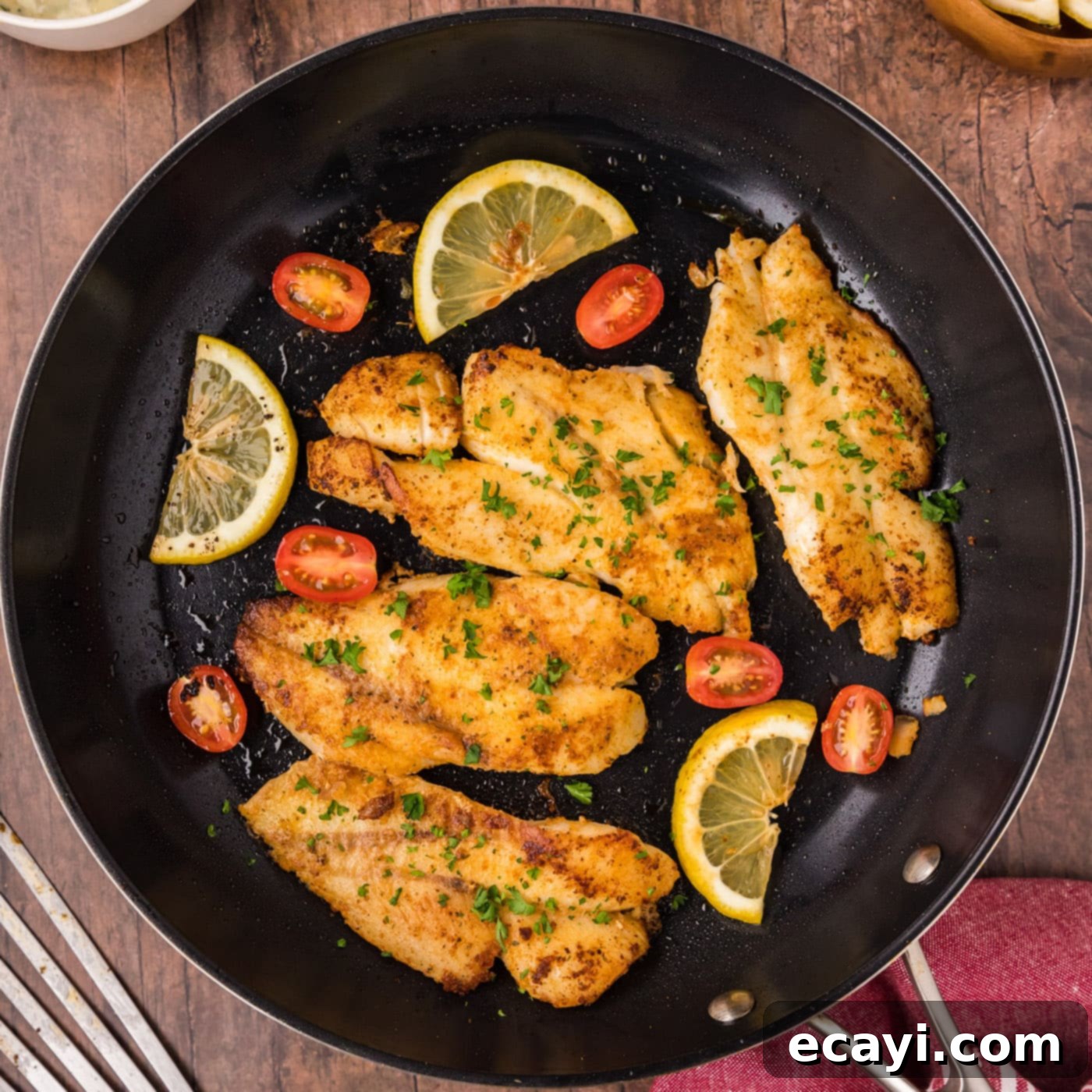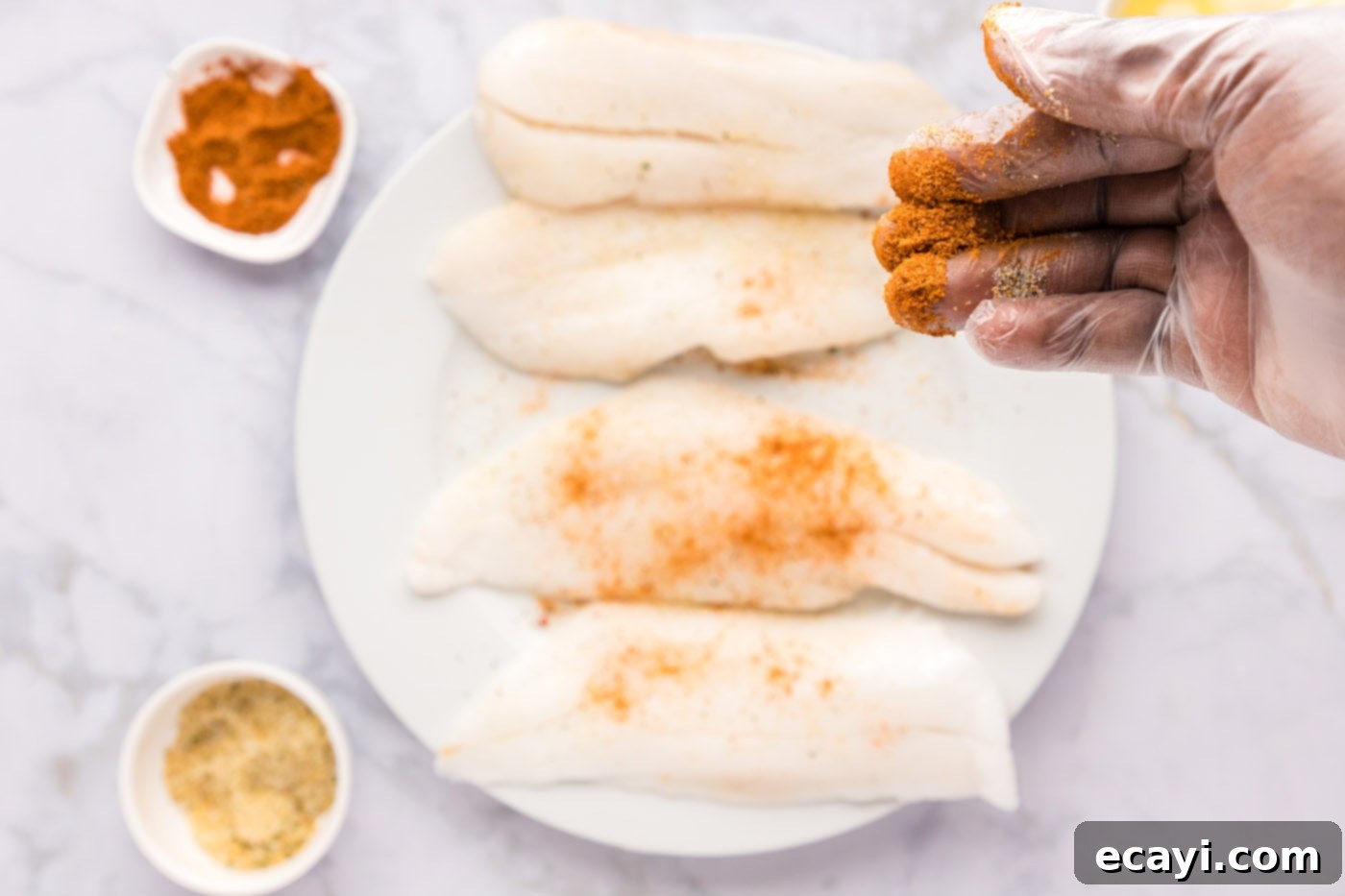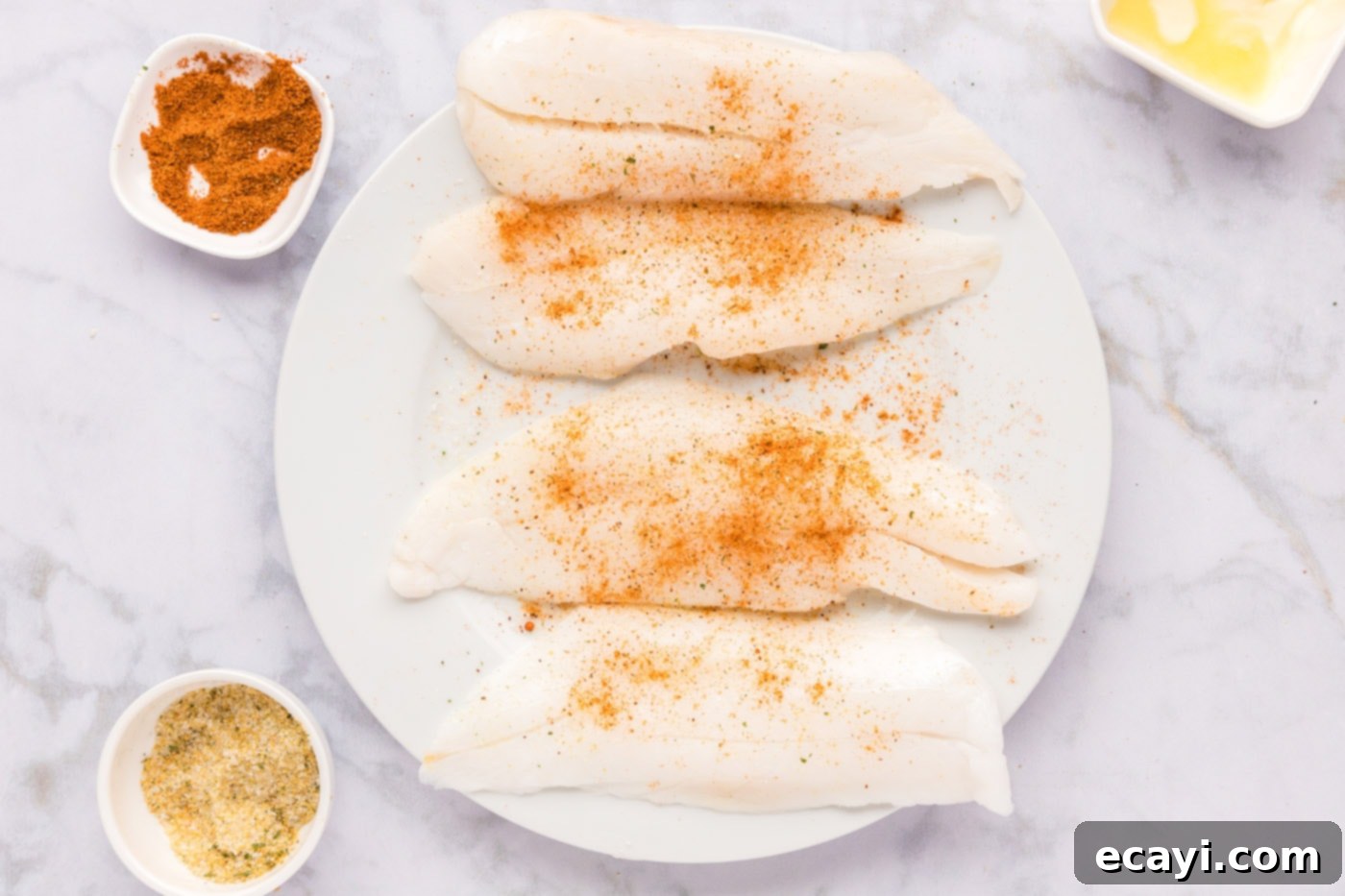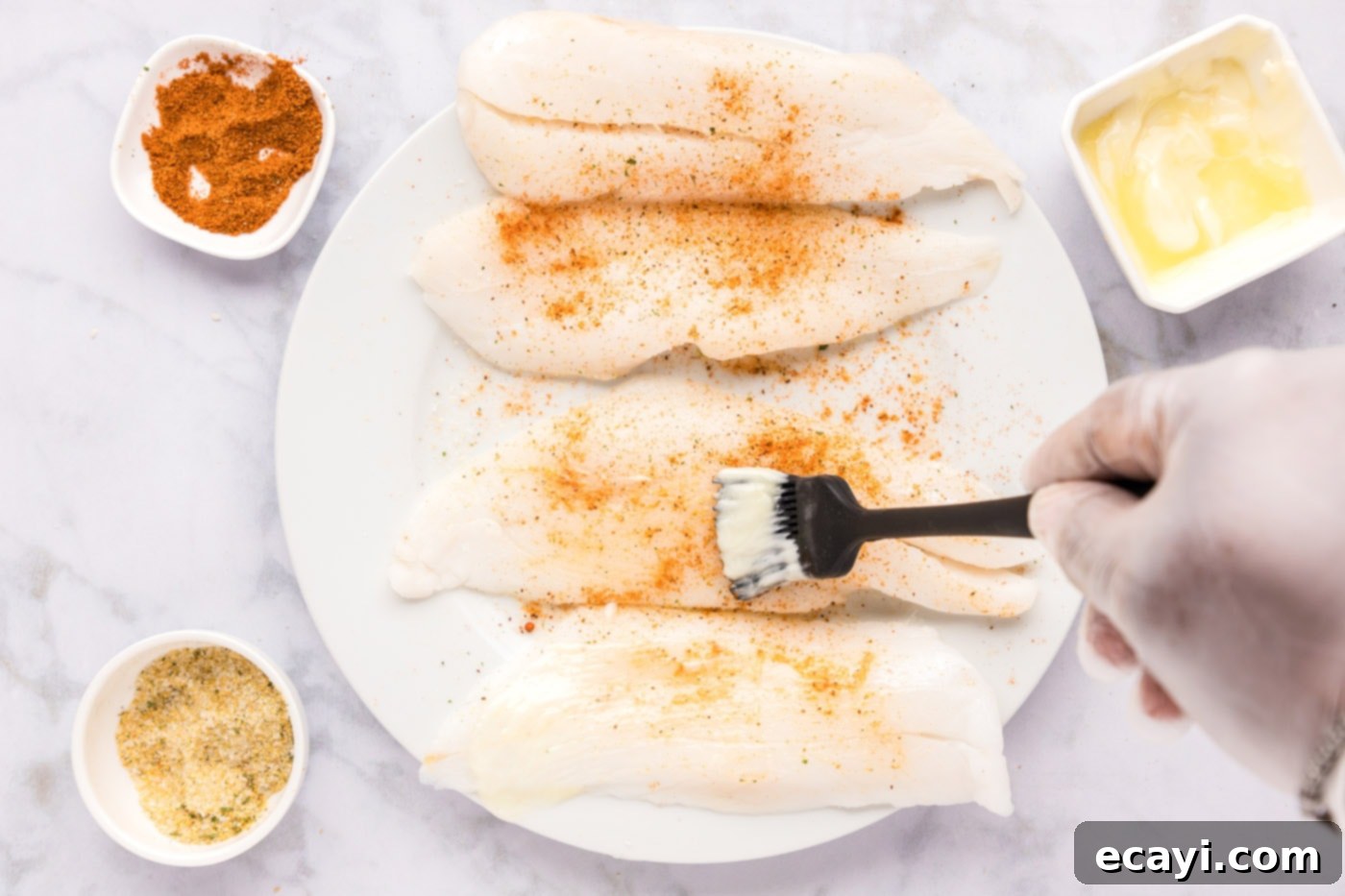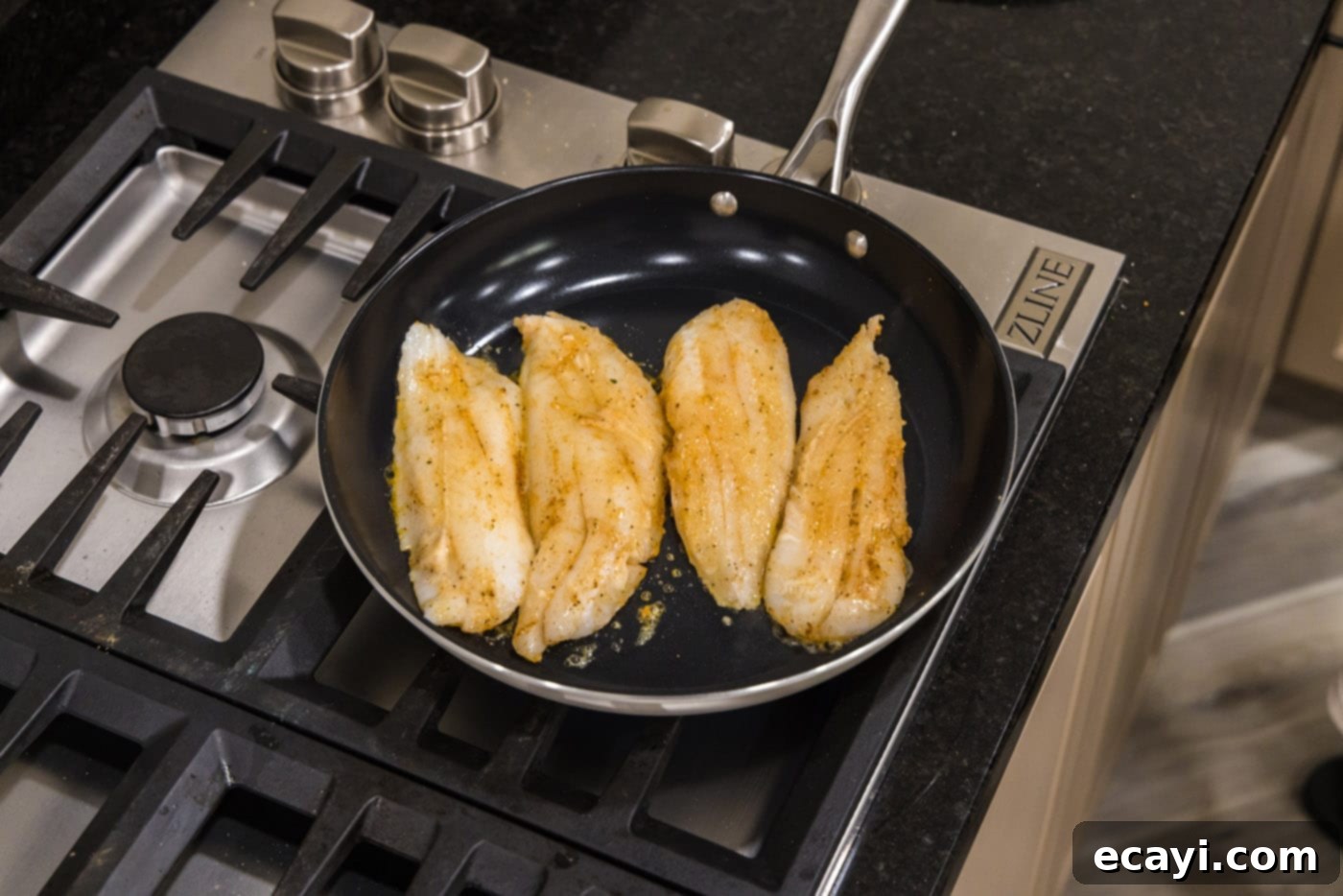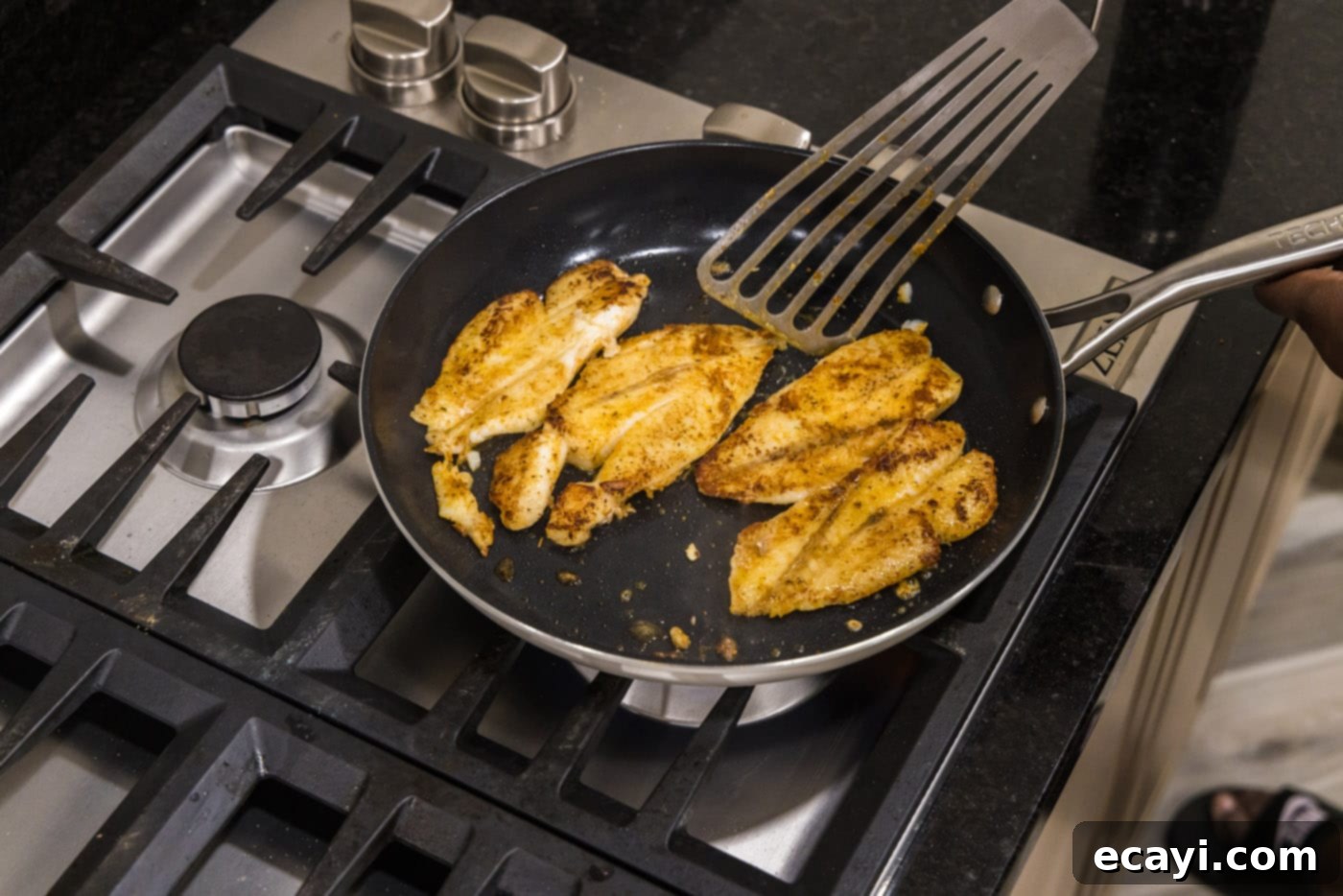Perfect Pan-Seared Orange Roughy Recipe: Tender & Flakey Fish in Minutes
Craving a delicious, healthy, and incredibly easy seafood dinner that comes together in a flash? Look no further than this fantastic pan-seared orange roughy recipe. In under 15 minutes, you can transform simple ingredients into tender, flakey fish filets with a beautiful golden crust. This recipe is perfect for busy weeknights when you want something gourmet without the fuss. With just four core ingredients, you’ll be amazed at how effortlessly you can create a meal that tastes like it came from a high-end restaurant.
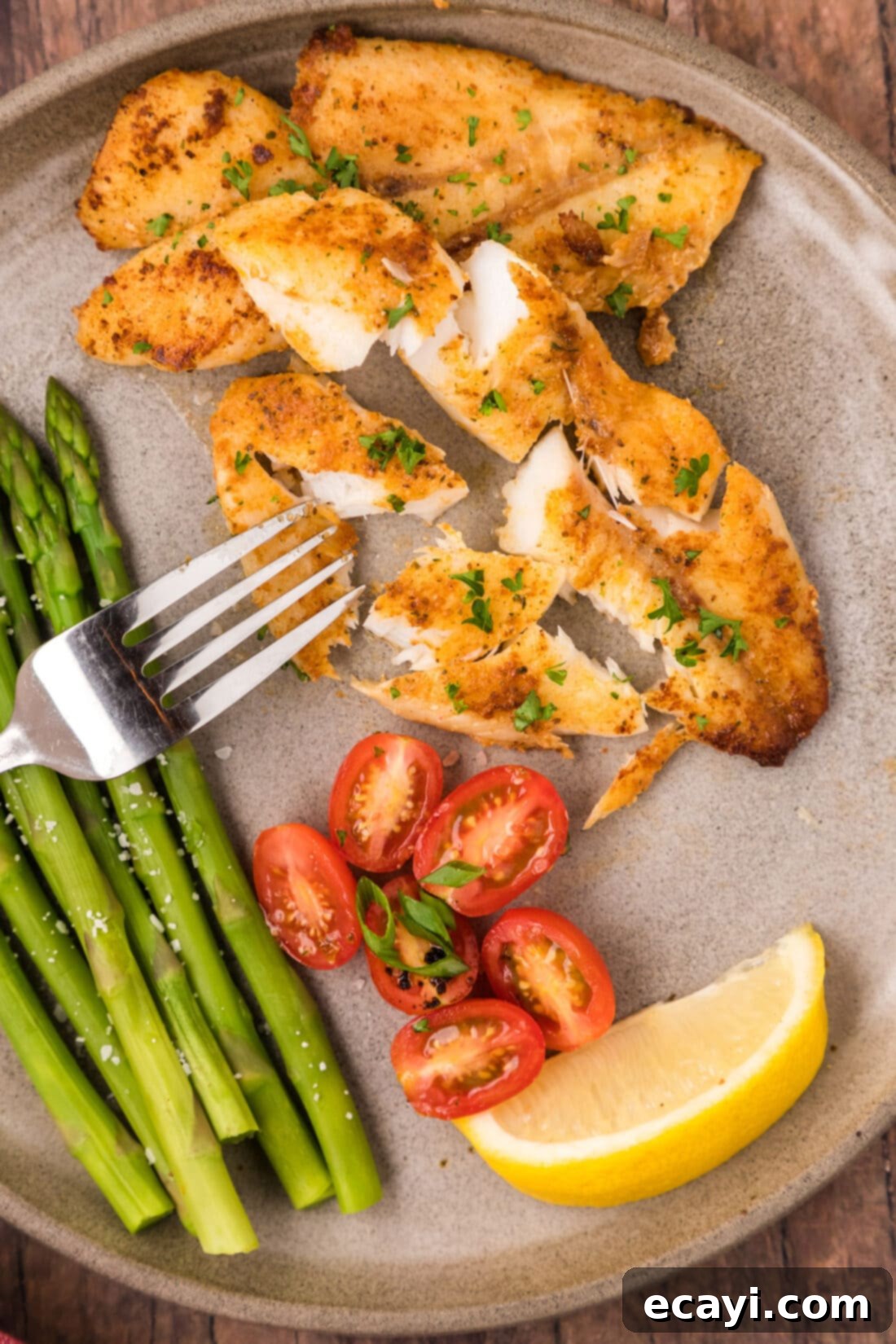
Why This Pan-Seared Orange Roughy Recipe Works Wonders
This recipe for pan-seared orange roughy stands out for several compelling reasons, making it a staple in any home cook’s repertoire. First and foremost, it’s incredibly quick, delivering golden, flakey fish to your table in less than 15 minutes. This speed is invaluable for weeknight dinners when time is often a luxury.
The success of this recipe lies in its simplicity and the inherent qualities of orange roughy. This mild-flavored fish, known for its delicate texture, is transformed by a quick sear in a hot skillet with just a touch of butter and the robust flavor of Old Bay seasoning. The butter contributes to a gorgeous golden crust and rich taste, while Old Bay adds a classic, savory depth that perfectly complements seafood.
Pan-searing is an ideal cooking method for orange roughy because it quickly cooks the delicate filets, locking in moisture and creating a desirable crisp exterior without overcooking the interior. This results in fish that is perfectly moist and flakes effortlessly at the touch of a fork. The process involves seasoning the orange roughy filets, brushing them generously with softened butter, and then searing them until golden-crusted and tender.
While delicious on its own, this mild fish is also incredibly versatile, making it perfect for topping with a generous drizzle of our homemade rosemary cream sauce. This optional addition elevates the dish with a creamy, aromatic finish, turning a simple meal into something truly special. If you prefer a different cooking method or are looking for alternatives, you can always hop over to our baked orange roughy recipe for instructions on how to cook this versatile fish in the oven.
Beyond its speed and flavor, this recipe is also a healthy choice, providing lean protein and essential nutrients. It’s a testament to how few ingredients and minimal effort can yield maximum flavor and satisfaction, making it a reliable and delightful option for any occasion.
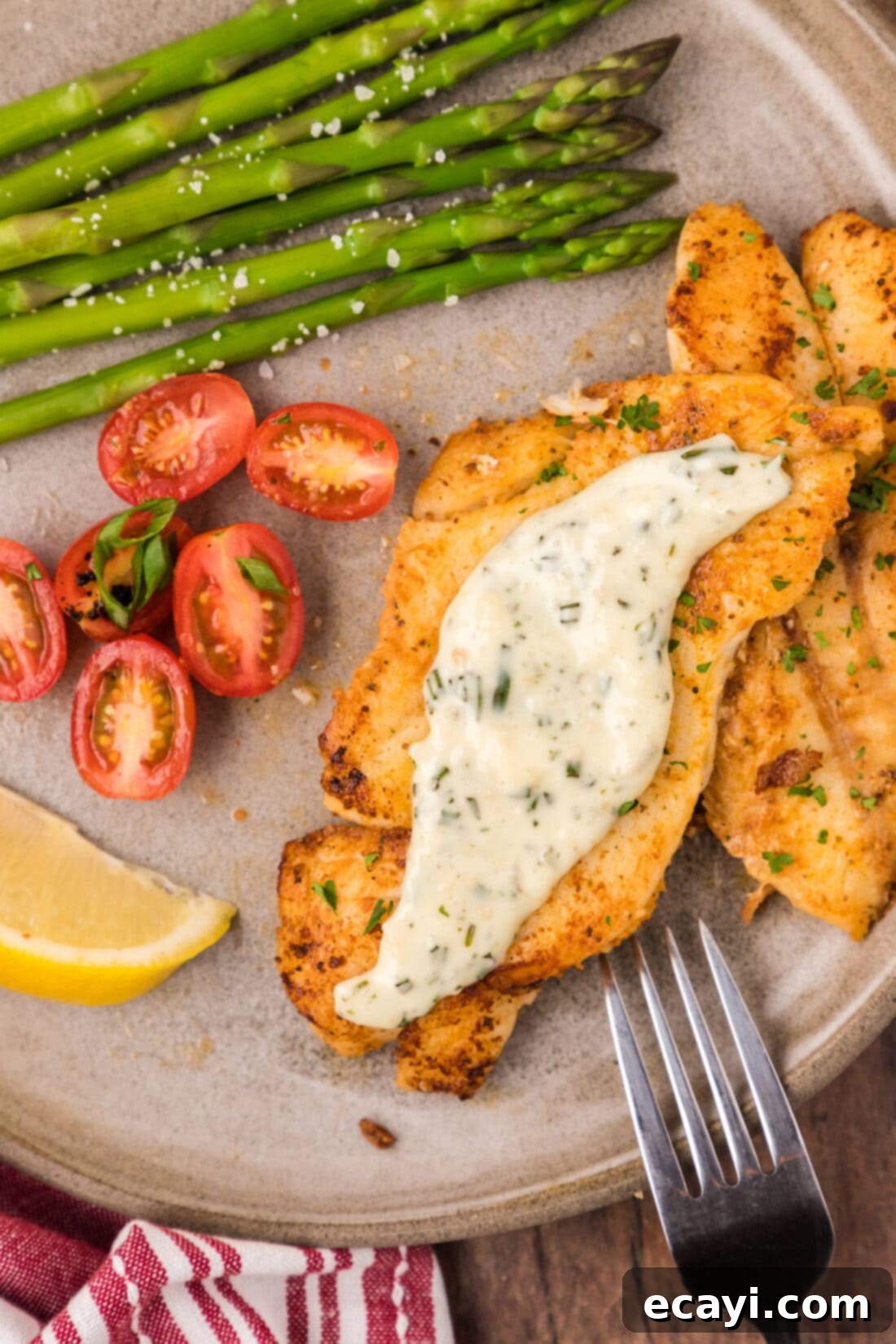
Essential Ingredients for Pan-Seared Orange Roughy
Creating this delicious pan-seared orange roughy requires only a handful of readily available ingredients. The key to a truly outstanding dish often lies in the quality of your components, so choose them wisely. You’ll find all specific measurements, quantities, and detailed instructions in the printable recipe card located at the very end of this post.
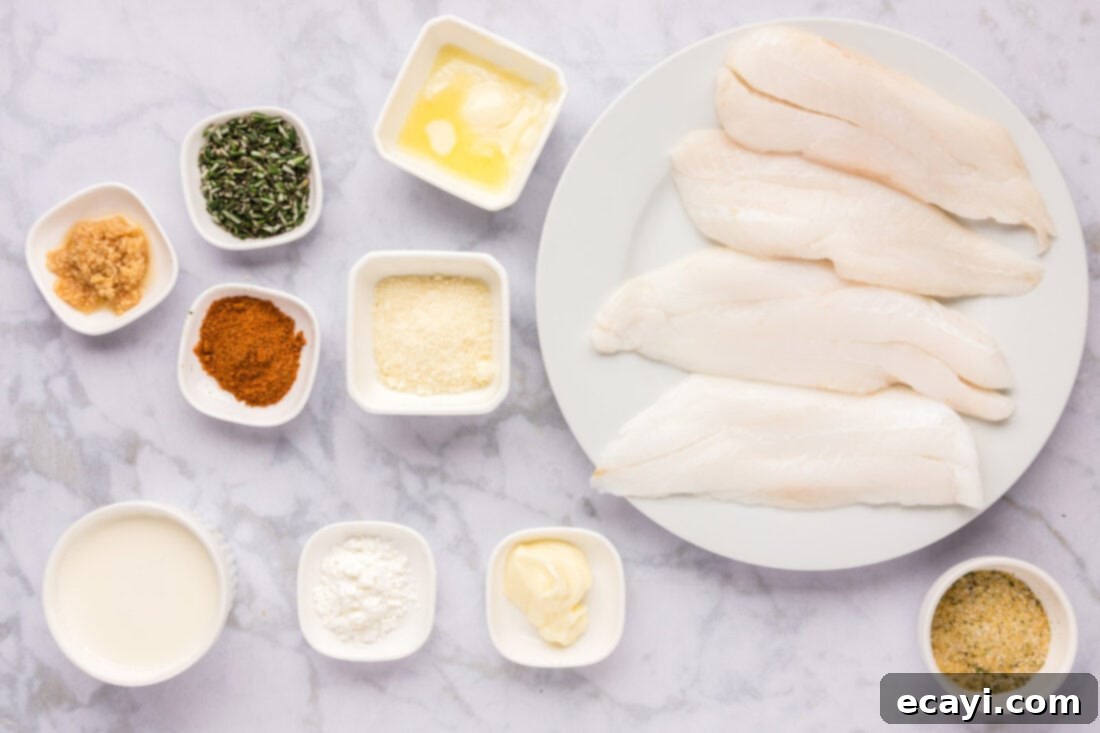
Ingredient Spotlight: Info and Substitution Ideas
Understanding your ingredients is crucial for culinary success. Here’s a closer look at what you’ll need and potential substitutions to keep your kitchen flexible.
FISH: Orange Roughy Filets
Orange roughy is a deep-sea fish known for its mild flavor and delicate, flakey texture, making it an excellent canvas for seasonings. It cooks quickly and absorbs flavors beautifully. When sourcing your orange roughy, you have a couple of options:
- Bagged Frozen Filets: These are widely available and convenient. However, it’s important to be aware that these filets can sometimes be thinner and occasionally broken. While perfectly fine for this recipe, you might find them less uniform in shape and size. Ensure they are fully thawed and patted very dry before cooking for the best sear.
- Fresh Filets from a Fish Market or Meat Counter: If you have access to a good fish market, you’ll often find thicker, more uniform, and higher-quality filets. These tend to hold their shape better during cooking and offer a slightly more substantial bite. Look for fish that smells fresh, like the ocean, not “fishy,” and has firm, translucent flesh.
Substitution Suggestions for Orange Roughy: If orange roughy isn’t available, or if you prefer another white fish, you can easily substitute it with other mild, flakey options such as:
- Cod: A popular choice, cod is firm, white, and flakes easily.
- Tilapia: Very mild and quick-cooking, similar to orange roughy in texture.
- Snapper: Offers a slightly firmer texture but still very delicate.
- Haddock: Another excellent white fish with a similar flakey consistency.
The cooking times might vary slightly depending on the thickness of your chosen fish, so keep an eye on it and check for an internal temperature of 145°F.
SEASONING: Garlic Salt & Old Bay Seasoning
These two seasonings are the backbone of flavor for our pan-seared orange roughy, creating a savory and slightly zesty profile that enhances the fish’s natural mildness.
- Garlic Salt: This staple provides a convenient blend of salt and dehydrated garlic, offering a savory, aromatic foundation. It’s essential for bringing out the inherent deliciousness of the fish.
- Old Bay Seasoning: A classic American seafood seasoning, Old Bay is a blend of 18 spices and herbs, including celery salt, paprika, black pepper, and various peppers. Its distinctive flavor is synonymous with seafood and creates an authentic coastal taste that is irresistible.
Substitution Suggestions for Seasonings: If you don’t have Old Bay or garlic salt on hand, or wish to experiment with different flavors:
- For Garlic Salt: Use regular salt and garlic powder separately (about ¼ tsp garlic powder + ¼ tsp salt per filet).
- For Old Bay: A blend of paprika, cayenne pepper (a pinch), onion powder, and celery seed can mimic some of its complexity. Lemon pepper seasoning or a simple mix of salt, pepper, and dill can also work well for a different, but equally delicious, flavor profile.
FAT: Butter (Softened)
Butter plays a crucial role in achieving that perfect golden crust and rich flavor. Softened butter is easier to brush onto the fish, ensuring an even coating that will melt beautifully in the hot pan.
Substitution Suggestions for Butter: While butter is highly recommended for its flavor, you can use other fats:
- Olive Oil or Avocado Oil: These oils have higher smoke points than butter and can also contribute to a crisp sear. They will impart a slightly different flavor profile.
- Clarified Butter (Ghee): If you want the butter flavor without the milk solids (which can burn more easily), clarified butter is an excellent choice. It has a higher smoke point, making it ideal for searing.
OPTIONAL SAUCE: Rosemary Cream Sauce
As pictured and mentioned, our homemade rosemary cream sauce is an optional, but highly recommended, addition. It adds a layer of creamy, herbaceous luxury that beautifully complements the mild fish. Please note that the ingredients listed in the recipe card below are for the orange roughy itself and do not include the components for this separate sauce. Be sure to check its dedicated recipe if you plan to make it!
Step-by-Step: How to Make Perfect Pan-Seared Orange Roughy
These step-by-step photos and instructions are here to help you visualize how to make this recipe. You can Jump to Recipe to get the printable version of this recipe, complete with measurements and instructions at the bottom.
- Prepare the Filets: Begin by carefully rinsing your orange roughy filets under cold water. This helps remove any loose scales or impurities. Once rinsed, it’s crucial to pat them thoroughly dry with paper towels. Excess moisture on the fish’s surface can prevent a proper sear, leading to steaming instead of browning.
- Season Generously: Place the dried filets on a clean surface. Season both sides generously with garlic salt and Old Bay seasoning. Distribute the seasonings evenly across the entire surface of the fish. Gently rub the spices into the flesh to ensure maximum flavor penetration.


- Butter Up: Take your softened butter and, using a pastry brush, apply a thin, even layer onto both sides of the seasoned filets. The butter will aid in browning and contribute a rich, savory flavor to the fish. Make sure every part of the filet is lightly coated.

- Heat the Skillet: Place a large, dry skillet (preferably cast iron or a heavy-bottomed non-stick pan for best results) over medium heat. Allow the skillet to heat up for 2-3 minutes. A properly hot pan is essential for achieving a perfect sear and preventing the fish from sticking. You can test the heat by flicking a few drops of water into the pan; if they sizzle and evaporate immediately, it’s ready.
- Sear to Golden Perfection: Carefully add the butter-brushed filets to the hot skillet. Do not overcrowd the pan; if you have many filets, cook them in batches to maintain high heat. Cook for 3-4 minutes on the first side until a beautiful golden-brown crust forms and the fish starts to become opaque around the edges. Then, using a fish turner or spatula, gently flip the filets over and cook for an additional 3-4 minutes on the other side, or until the fish is cooked through and flakes easily with a fork. The internal temperature should reach 145°F.


- Serve Immediately: Once cooked, remove the orange roughy filets from the skillet and transfer them to individual plates. Serve them hot and enjoy the tender, flakey goodness right away for the best flavor and texture.
Frequently Asked Questions & Expert Tips for Orange Roughy
While this pan-seared orange roughy is truly at its best when served fresh, you can certainly store any leftovers. Place them in an air-tight container and keep them in the refrigerator for 1-2 days. For reheating, the microwave is a quick option, but to retain some of that delicate texture, gently reheat in a lightly oiled pan on the stovetop over low heat, or in a preheated oven at 275°F (135°C) until just warmed through. Be careful not to overcook, as this can dry out the fish.
Orange roughy, like most fish, is fully cooked and safe to eat when it reaches an internal temperature of 145°F (63°C). You can verify this by inserting an instant-read thermometer into the thickest part of the fish. Visually, the fish will look golden brown on the outside and should flake easily with a fork, turning opaque throughout the center. No translucent or raw-looking areas should remain.
Yes, you can absolutely use frozen orange roughy! However, it is crucial to thaw it completely before cooking. You can thaw it overnight in the refrigerator or by placing the sealed package under cold running water for about 30 minutes. Once thawed, pat the filets very dry with paper towels. Cooking frozen fish directly will result in a steamed, rather than seared, texture and can lead to uneven cooking.
A heavy-bottomed skillet is ideal for pan-searing fish as it distributes heat evenly and maintains a consistent temperature. Cast iron skillets are excellent for achieving a perfect crust, but a good quality non-stick pan also works wonderfully, especially if you’re concerned about the fish sticking. Ensure the pan is large enough to accommodate the filets without overcrowding, allowing for proper browning.
Orange roughy is a good source of lean protein and low in calories, making it a healthy addition to your diet. While it contains some omega-3 fatty acids, other fish like salmon or mackerel are higher in these beneficial fats. However, it still offers essential nutrients and is a delicious way to enjoy seafood as part of a balanced diet.
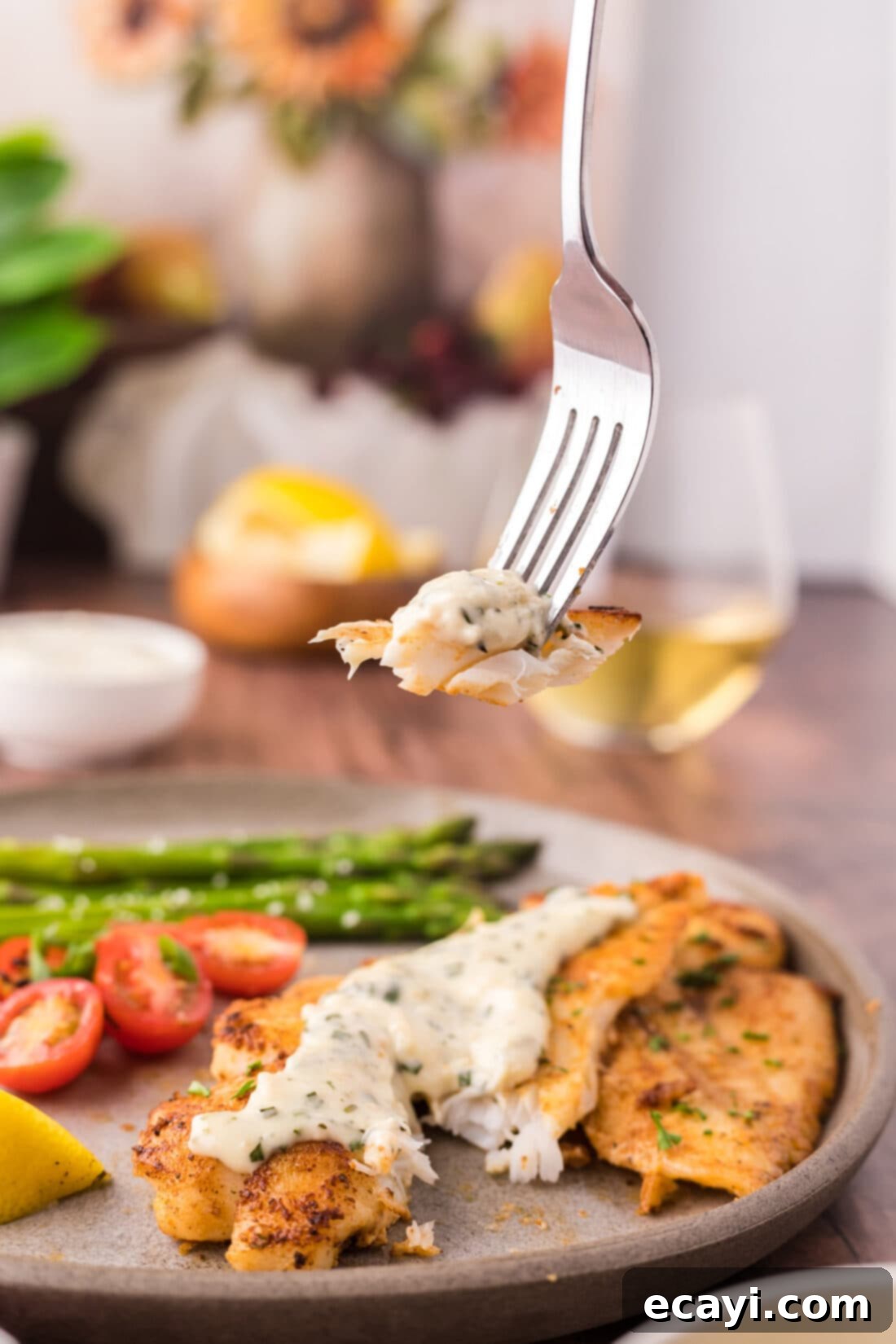
Delightful Serving Suggestions for Orange Roughy
Pan-seared orange roughy is a versatile dish that pairs beautifully with a variety of sides and sauces. As previously mentioned, it pairs exceptionally well with our creamy and aromatic rosemary cream sauce, which elevates the meal to a gourmet level. However, its mild flavor also means it’s delicious served simply on its own with a fresh squeeze of lemon juice, which brightens the entire dish.
For a complete and balanced meal, consider these fantastic side dish ideas:
- Vegetables: Light and fresh vegetables are always a good choice. Serve alongside steamed or roasted asparagus, sautéed green beans with a hint of garlic, or broccoli florets. A colorful medley of roasted bell peppers and zucchini also makes an excellent accompaniment.
- Potatoes and Grains: Classic choices include creamy mashed potatoes, crispy roasted potatoes, or a light potato salad. For grain options, fluffy white rice, quinoa, or couscous can absorb any delicious pan juices or sauces.
- Salads: A crisp, leafy dinner salad with a light vinaigrette provides a refreshing contrast to the warm fish. You could also opt for a more substantial salad, like a Mediterranean quinoa salad or a citrus-infused arugula salad.
- Breads: A crusty baguette or some warm garlic bread is perfect for soaking up any remaining sauce.
Beyond the rosemary cream sauce, other sauces that complement orange roughy include a simple lemon-butter sauce with fresh dill or parsley, a bright caper sauce, or even a light tomato salsa for a touch of acidity and freshness.
To round out your meal, consider a crisp white wine, such as Sauvignon Blanc or Pinot Grigio, which beautifully complements the delicate flavor of the fish.
Explore More Delicious Fish Recipes
If you loved this orange roughy recipe, you’ll be thrilled to discover more of our fantastic fish and seafood creations. Expand your culinary horizons with these other reader favorites:
- Hearty & Creamy Fish Chowder
- Perfectly Grilled Salmon
- Crispy Fried Whiting Fish
- Classic Beer Battered Fish
- Effortless Baked Orange Roughy
I love to bake and cook and share my kitchen experience with all of you! Remembering to come back each day can be tough, that’s why I offer a convenient newsletter every time a new recipe posts. Simply subscribe and start receiving your free daily recipes!
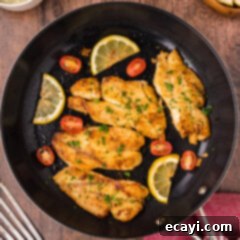
Pan-Seared Orange Roughy
IMPORTANT – There are often Frequently Asked Questions within the blog post that you may find helpful. Simply scroll back up to read them!
Print It
Pin It
Rate It
Save ItSaved!
Ingredients
- 12 ounces orange roughy filets (approximately 4 filets)
- ½ Tablespoon garlic salt
- ½ Tablespoon Old Bay seasoning
- 1 Tablespoon butter softened
Things You’ll Need
-
Large skillet
-
Vinyl gloves (optional, for handling fish)
-
Fish turner or spatula
Before You Begin
- If buying bagged frozen Orange Roughy filets, be aware that the filets can be thinner and sometimes broken up. For best results, ensure they are fully thawed and patted very dry before cooking. Thicker, more uniform filets are often found at fish markets.
- This fish is best served immediately after cooking to enjoy its optimal texture and flavor. However, leftovers can be stored in an air-tight container in the refrigerator for 1-2 days. Reheat gently in the microwave or a low oven to prevent drying out.
- Ensure your skillet is properly heated before adding the fish to achieve a perfect sear and prevent sticking.
Instructions
-
Rinse orange roughy filets under cold water and pat them thoroughly dry with paper towels to ensure a crisp sear.
-
Season the filets generously on both sides with garlic salt and Old Bay seasoning, rubbing it in gently.
-
Brush softened butter evenly onto both sides of the seasoned filets.
-
Heat a large, dry skillet over medium heat for 2-3 minutes until hot.
-
Carefully add the filets to the hot skillet. Cook for 3-4 minutes until golden-brown, then flip and cook for an additional 3-4 minutes on the other side, or until the fish is opaque and flakes easily (internal temperature 145°F/63°C).
-
Remove from skillet and serve immediately for the best taste and texture.
Nutrition
The recipes on this blog are tested with a conventional gas oven and gas stovetop. It’s important to note that some ovens, especially as they age, can cook and bake inconsistently. Using an inexpensive oven thermometer can assure you that your oven is truly heating to the proper temperature. If you use a toaster oven or countertop oven, please keep in mind that they may not distribute heat the same as a conventional full sized oven and you may need to adjust your cooking/baking times. In the case of recipes made with a pressure cooker, air fryer, slow cooker, or other appliance, a link to the appliances we use is listed within each respective recipe. For baking recipes where measurements are given by weight, please note that results may not be the same if cups are used instead, and we can’t guarantee success with that method.
